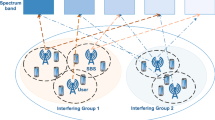Abstract
In this paper, we design a dynamic spectrum allocation (DSA) scheme for heterogeneous cellular wireless networks with special interest on guaranteeing the cell coverage probability. To this end, considering users spatial distribution, we propose a new interference control (IC) model, which guarantees SINR (signal to interference plus noise ratio) requirements of different services and ensures the coverage performance of base stations (BSs). Under such an IC model, we formulate the DSA scheme as a combinatorial optimization problem. Since the problem is computationally intractable, we design an algorithm for its solution based on graph coloring. Simulation results indicate that the proposed DSA scheme can increase the total spectrum utility while effectively controlling the interference among BSs and meeting SINR requirements of users.
Similar content being viewed by others
References
FCC. Spectrum Policy Task Force Report. 2002
Mitola J. Cognitive Radio. Dissertation of Doctoral Degree. Swedish: Royal Institute of Technology (KTH), 2000
Subramanian A P, Al-Ayyoub M, Gupta H, et al. Near-optimal dynamic spectrum allocation in cellular networks. In: Proceedings of Symposium on New Frontiers in Dynamic Spectrum Access Networks, Chicago, 2008. 1–11
Im S, Kang Y, Kim W, et al. Dynamic spectrum allocation with efficient SINR-based interference management. In: Proceedings of Vehicular Technology Conference, San Francisco, 2011. 1–5
Feng Z Y, Li W, Li Q, et al. Dynamic spectrum management for WCDMA/DVB heterogeneous systems. IEEE Trans Wirel Commun, 2011, 10: 1582–1593
Alnwaimi G, Arshad K, Moessner K. Dynamic spectrum allocation algorithm with interference management in coexisting networks. IEEE Commun Lett, 2011, 15: 932–934
Buddhikot M M, Ryan K. Spectrum management in coordinated dynamic spectrum access based cellular networks. In: Proceedings of Symposium on New Frontiers in Dynamic Spectrum Access Networks, Baltimore, 2005. 299–307
IEEE. IEEE Standard for Architectural Building Blocks Enabling Network-Device Distributed Decision Making for Optimized Radio Resource Usage in Heterogeneous Wireless Access Networks. IEEE Standard 1900.4. 2009
Leaves P, Moessner K, Tafazolli R, et al. Dynamic spectrum allocation in composite reconfigurable wireless networks. IEEE Commun Mag, 2004, 42: 72–81
Leaves P, Ghaheri-Niri S, Tafazolli R, et al. Dynamic spectrum allocation in hybrid networks with imperfect load prediction. In: Proceedings of the 3rd International Conference on 3G Mobile Communication Technologies, London, 2002. 444–448
Marks P, Pearson K, Williamson B, et al. Estimating the commercial trading value of spectrum. A report for Ofcom by Plum Consulting. 2009. http://www.plumconsulting.co.uk/pdfs/Plum_July09_Commercialtradingvalueofspectrum.pdf
Author information
Authors and Affiliations
Corresponding author
Rights and permissions
About this article
Cite this article
Shi, H., Li, J., Ma, Y. et al. Coverage probability driven dynamic spectrum allocation in heterogeneous wireless networks. Sci. China Inf. Sci. 56, 1–7 (2013). https://doi.org/10.1007/s11432-013-4920-8
Received:
Accepted:
Published:
Issue Date:
DOI: https://doi.org/10.1007/s11432-013-4920-8




